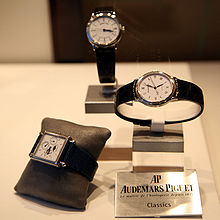Audemars Piguet
| Audemars Piguet Holding SA | |
|---|---|
| legal form | Corporation |
| founding | 1875 |
| Seat |
Le Brassus , Switzerland |
| management |
|
| Number of employees | 1200 (2013) |
| sales | 530 million CHF (2007) |
| Branch | Watch manufacture |
| Website | www.audemarspiguet.com |
The Audemars Piguet Holding SA is a Swiss watch manufacturer group based in Le Brassus in the canton of Vaud . At its three production sites in Le Brassus, Le Locle and Meyrin , it manufactures watches in the top price range. Annual production amounts to around 40,000 watches. The group of companies employs 800 people, 610 of them in Switzerland, and in 2007 generated sales of 530 million Swiss francs .
History and Development
In 1875 , shortly after completing his training as a repasseur , (Jules) Louis Audemars began making his own watches in Le Brassus. He occasionally received support from his childhood friend Edward-Auguste Piguet , also a repasseur. On December 17, 1881 , they founded the joint company Audemars, Piguet & Cie. and immediately started producing complicated pocket watches. As early as 1882, they had their own models with a perpetual calendar , minute repeater or chronograph . In 1889 her pocket watch "Grande Complication" won a medal at the Paris World Exhibition . Two years later they created the world's smallest minute repeater movement and in 1891 the first wristwatch with a minute repeater.
The company quickly gained notoriety and was able to open branches in Berlin , London , Paris , New York and Buenos Aires , among others .
After the death of the company's founders Audemars in 1918 and Piguet in 1919, the heirs turned to the development and manufacture of high-quality wristwatches. Fashionable watches were created, the market demanded precious metals and stones. The company benefited from the high quality of its products, and early on supplied ébauches and entire watches to well-known jewelers such as Van Cleef & Arpels in Paris or Tiffany in New York, who then sold them under their own name. Audemars Piguet survived the global economic crisis and was able to develop further during the Second World War due to the large, above all US American, demand for wrist chronographs .
Audemars Piguet only achieved its greatest success after the Second World War. The "Royal Oak", designed by Gérald Genta in 1972, has become a classic in the model range . Other clocks followed, such as In 1986, for example, the thinnest bracelet tourbillon with an automatic winding mechanism or in 1993 the first wristwatch with grande and petite sonnerie and quarter repeater.
Well-known and current model series
- "La Grande Complication" pocket watch, only 100 pieces made from 1915 to 1989
- "Royal Oak" - sports watch made of stainless steel, design Gérald Genta (from 1972)
- "Royal Oak Offshore" - reinterpretation of the familiar model (from 1992)
- «Jules Audemars» - Classic wristwatch, various complications and materials
- "Edward Piguet" - Classic wristwatch, various complications and materials
- «Millenary» - Modern wristwatch, various complications and materials
Trivia
Among other things, the company gained fame as a sponsor of the America's Cup winning team Alinghi . Many celebrities are among the followers of this brand. For example, in two of his films ( End of Days and Terminator 3 ) Arnold Schwarzenegger wore specially made and limited editions of the "Royal Oak Offshore" series. Another special edition is called “Royal Oak Offshore Pablo Montoya” and is offered in a special edition in titanium, rose gold or platinum.
In October 2012 a limited edition for and with Formula 1 racing legend Michael Schumacher was presented in Berlin. This edition also consists of three models with either a titanium (1000 pieces), rose gold (500 pieces) or platinum watch case (100 pieces). Michael Schumacher's seven world championship titles are shown on it with seven small stars, two blue for Benetton and five red for Ferrari, to the right of the 12 o'clock mark.
literature
- Pierre Audemars: Louis Audemars - the golden age. In: Journal Suisse d'Horlogerie et de Bijouterie, year 1954, pp. 151–155, 237–241, 301–305, 471–476, and year 1955, pp. 93–95.
- Gisbert L. Brunner : Audemars Piguet - Manufacture d'Horlogerie. In: Old clocks. No. 4, 1986, pp. 9-40.
- Gisbert L. Brunner, Christian Pfeiffer-Belli, Martin K. Wehrli: Audemars Piguet. Masterpieces of classic watchmaking. Callwey, Munich 1992, ISBN 3-7667-1045-1 .
- Hartmut Zantke: Louis-Benjamin Audemars. His life and work. The rise and fall of a watchmaking dynasty. Social card index publishing house, Stuttgart 2003, ISBN 3-00-012191-9 .
Web links
- Company website
- Literature by and about Audemars Piguet in the catalog of the German National Library
Individual evidence
- ↑ a b In the valley of clocks (4) - Audemars Piguet. In: Manager Magazin , August 15, 2008.
- ↑ a b c Gisbert L. Brunner: wrist watches. From the first chronometer on the wrist to a coveted collector's item (= Heyne-Bücher 8, 9323). Revised new edition. Heyne, Munich 1996, ISBN 3-453-11490-6 , pp. 314-316.
- ↑ a b Michael Balfour: The classic wristwatch. The big wristwatches and their manufacturers from the beginning until today. Parkland, Cologne 1996, ISBN 3-88059-866-5 , p. 27.

